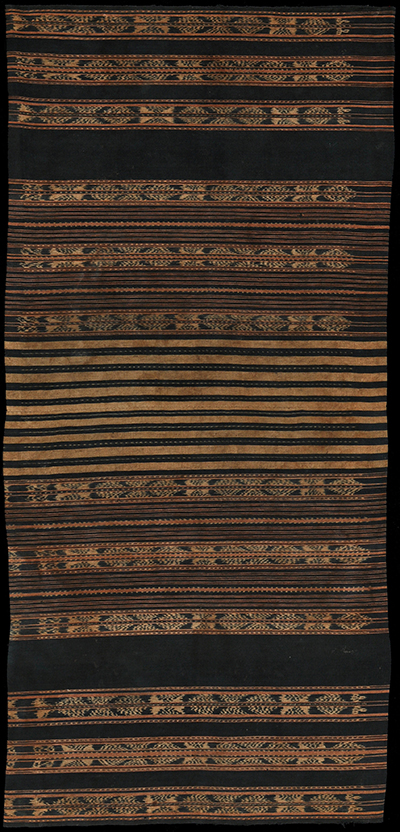| |
 
 | | | |
261 Moluccas, Tanimbar
Bakan (sarong)  
| | Locale: | Possibly Awaer on Fordata. | | Period: | Circa 1900 | | Yarn: | Cotton, hand-spun, medium | | Technique: | Warp ikat | | Panels: | 2 | | Size: | 67 x 130.5 cm (2' 2" x 4' 3") LW: 1.95 | | Weight: | 515 g (18.2 oz), 295 g/m2 (0.97 oz/ft2) | | Design: | Sarong of a type called bakan maran or tais matin depending on the island where it was made. Maran is the name for the striped midsection, which here has nine 'white' stripes in the mid-field, rather than the eleven more common nowadays. The light coloured broad triangle motif is a prettified version of the traditional Tanimbarese 'flag' and 'half moon' combination. Both here are enriched by additional tiny dots that hugely increase the complexity of the ikat work, as they require countless tiny additional bindings. Counting inward from the extremities, bands 1 and 3 are identical, whereas 2, 4, 5 and 6 end in a double S-motif. Noteworthy is the absence of 'rainbow stripes', apparently a style element that came en-vogue later. | | Comment: | Made of very fine hand spun cotton (see microscopic images). The brownish tinge of the undyed parts of cotton may indicate that the skeins were smoked to obtain an ecru tint close to that of lontar. In the traditional ranking of Tanimbar this cloth would rate in the middle of the scale. Still it was apparently considered important enough to use cotton, rather than lontar, which at the time was more common, and opt for the finest thinkable ikating of the standard patterns. Nowadays old examples of this quality are quite rare. The flag-motif stands for victory, as well as associations and marital bonds; the half moon stands for fertility. Ex collection J.B. Lüth. | | Background: | Chapters on Moluccas and Tanimbar. | | Exhibited: | Roemer Museum, Hildesheim, 1991. Hong Kong University Museum and Art Gallery, 2017. | | Published: | Brigitte Khan Majlis, Woven Messages, 1991.
Ikat Textiles of the Indonesian Archipelago, 2018.
| | Sources: | Depicted in Khan Majlis, Woven Messages, Fig. 317. Van Vuuren mentions emulation of lontar ikat by hanging skeins in smoky environment in Ikat from Tanimbar, p. 34. S-motif, Fig. 4, p. 156. Additional information, Van Vuuren, personal communication, 2016. Mc Kinnon, Flags and Half Moons, shows a sarong of similarly intricate patterning from Awear on Fordata. A similar example in the Thomas Murray collection is shown in Aragon et al., Indonesian Textiles, Fig. 9.11. | | |

©Peter ten Hoopen, 2025
All rights reserved.
|
|


